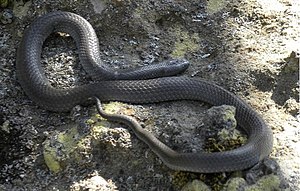Eastern small-eyed otters
| Eastern small-eyed otters | ||||||||||||
|---|---|---|---|---|---|---|---|---|---|---|---|---|

Eastern small-eyed viper ( Cryptophis nigrescens ) |
||||||||||||
| Systematics | ||||||||||||
|
||||||||||||
| Scientific name | ||||||||||||
| Cryptophis nigrescens | ||||||||||||
| ( Günther , 1862) |
The eastern small-eyed viper ( Cryptophis nigrescens ) belongs to the genus Cryptophis within the family of poisonous snakes (Elapidae) . The first scientific description took place in 1862 by the German zoologist Albert Günther as Hoplocephalus nigrescens . At times the eastern small- eyed viper was assigned to the genus Rhinoplocephalus .
features
The species reaches a total length between 50 and 100, a maximum of 120 cm. The body is strongly built and looks cylindrical. It is solid gray and very dark in color. The head, slightly but visibly separated from the body, is short and flat, the eyes are very small. The tail is quite short. The shiny body scales are not keeled.
distribution and habitat
The eastern small-eye viper is common in eastern Australia from Cape York in Queensland to southern Victoria . It inhabits a wide variety of habitats, including tropical rainforests, tree and scrubland, dry heathland and stony rock regions. During the day it hides under stones, dead wood and buried in the ground.
Way of life
Cryptophis nigrescens is nocturnal. The poisonous snake searches for food in the vegetation and between rocks. It preyed on sleeping birds and reptile eggs, but above all lizards . As an ophiophage , it also eats other snakes.
The eastern small eye snake reproduces through ovoviviparia , giving birth to young snakes in a soft egg shell, which is pierced at or immediately after birth. A litter comprises one to eight young snakes, which are already relatively large.
Snake venom
Often referred to as harmless in the past, it is now clear that the bite of this snake can be fatal for humans. At least one death has been proven so far. The eastern small-eye otter produces a toxin which has particularly myotoxic properties ("muscle poison"). It attacks the striated muscles ( skeletal muscle and heart muscle ), which can result in severe muscle pain, loss of control of the lower limbs, myoglobinuria, and cardiac arrest . As an indirect consequence, damage to the kidneys from myoglobin and destroyed muscle cells is to be feared. There is currently no antivenin , so treatment of a poison bite by a doctor must be symptomatic. Bite accidents with this species only occur occasionally.
supporting documents
Individual evidence
- ↑ Cryptophis nigrescens in The Reptile Database (accessed July 5, 2018)
literature
- Mark O'Shea: Venomous snakes - All kinds of the world in their habitats , Kosmos Verlag, 2006. ISBN 3-440-1061-95 .
- Dieter Schmidt: Atlas Schlangen , Nikol-Verlag, 2006. ISBN 978-3-86820-011-9 .
- Chris Mattison: Encyclopedia of the Snakes , blv Verlag, 2007. ISBN 978-3835403604 .
Web links
- Cryptophis nigrescens in The Reptile Database
- Krista DeMattio: Rhinoplocephalus nigrescens ( Memento from March 10, 2011 in the Internet Archive ) (Engl., PDF; 16 kB)